
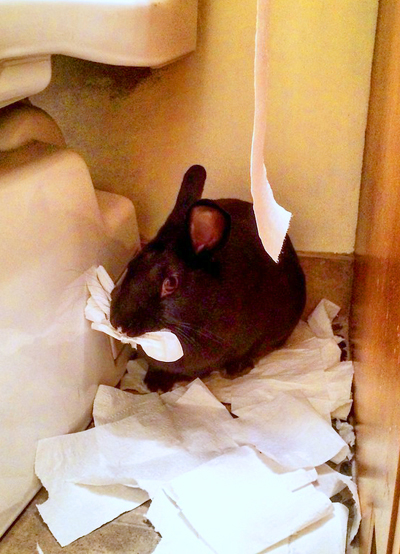
Behold the “naughty rabbit”! He (or she) who chews, digs or makes a mess where it’s not wanted! How can you make your rabbit “be good”?
Rabbits are natural chewers and diggers. When a rabbit enters a space, she may see the same objects you do, but to her, their purpose is different. It generally falls into one of these basic categories: eating, chewing, digging, running on, climbing on, or useless. When the space in question is your home, you may not be very pleased about her conclusions! But she is not being naughty. You and your rabbit just see things differently.
Luckily, rabbit behavior can be managed, using a combination of:
- Enrichment – providing safe, human-approved ways for bunny to do the things she enjoys
- Prevention – making unwanted activities impossible or unsatisfying
Rabbit-proofing is the prevention part.
This post will be about the basics of rabbit-proofing. This is a to-do list for anyone who is bringing a new rabbit home, or who wants to expand the free-running time or range of their rabbit. The goal is to make it safe for your whisker-nose to roam around without constant supervision.
Electrical Cords
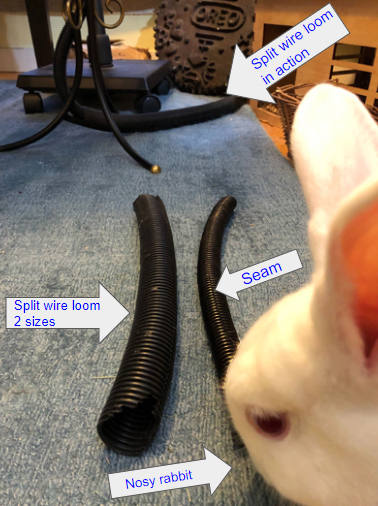 Electrical cords are my #1 concern when a rabbit is in a human space. IMHO, eliminating all access to electrical wiring is absolutely essential, even if you don’t think your rabbit is interested or much of a chewer. Why risk it? The failure scenarios can be catastrophic for both the rabbit and the appliance!
Electrical cords are my #1 concern when a rabbit is in a human space. IMHO, eliminating all access to electrical wiring is absolutely essential, even if you don’t think your rabbit is interested or much of a chewer. Why risk it? The failure scenarios can be catastrophic for both the rabbit and the appliance!
The easiest way to deal with electrical wires is to put them places the bun simply cannot go, such as behind a piece of furniture that is flush with the wall. Similarly, up on top of counters or furniture that is too high to be accessed by inquiring teeth. Look carefully to make sure that the cord isn’t hanging down, dangling underneath, or sticking out the sides. So long as you keep the entire wire in a secure “no-go” zone, you’re all set.
There are inevitably some cords that can’t be put entirely out of reach. Floor lamps are a good example. Fortunately, the universe has given us Split Wire Loom. This is a corrugated plastic tube with a slit cut all the way along its length. The slit allows you to tuck your electrical cord(s) inside the tube. You can buy split wire loom in many lengths or on big rolls if you have a lot of rabbit-proofing to do! It can easily be cut with a scissors to just the right lengh, so no naked wire is sticking out at either end. It even comes in a variety of colors in case you feel inspired to match your decor.
Split wire loom is also made in many diameters, which can be nested inside each other. For cords that are in very high-rabbit-traffic spots, it’s a good idea to use 2 or 3 layers. In those situations, often bunnies will chew on the loom itself. Give your looms a little inspection every now and then to make sure no cord is left exposed.
Plants
If you enjoy having potted plants, it is pretty discouraging to have one obliterated by a rabbit. But even worse, they might make your bunny sick. I don’t keep plants in my house that I know are toxic to bunnies because there have been countless times when my best rabbit-proofing efforts have been thwarted. Orchid blossoms have been poached from the top of the dining room table! (Someone was able to stretch just far enough to pull the tip of a leaf and topple the plant on its side, leaving the helpless blossoms cantilevered well within reach.) Air plants have mysteriously disappeared (into thin air?)! I’m happy to say that no rabbit was ever the worse for wear in any of these cases.
With the plants you wish to keep, obviously you have to find places for them that bunny can’t possibly reach. Even then, keep an eye on them as they may stray into reachable space as they grow! Finnegan has been known to stretch his body to twice its normal length trying to reach a dangling plant leaf. It really is quite impressive!
Anything Plant-Based
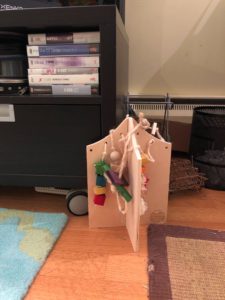 Books. Old LP’s with cardboard covers. Newspapers, magazines, baskets, wicker furniture, refund checks, These are all things that I would recommend you manage carefully with rabbits in your home. Not that I’ve had any bad experiences. <Ahem> I have more books with chewed spines than I can count. Mostly I smile when I see the tooth marks, but not everyone finds it endearing. That said, I now have bookcases that have doors covering their lower shelves. (Very reasonably priced from IKEA.)
Books. Old LP’s with cardboard covers. Newspapers, magazines, baskets, wicker furniture, refund checks, These are all things that I would recommend you manage carefully with rabbits in your home. Not that I’ve had any bad experiences. <Ahem> I have more books with chewed spines than I can count. Mostly I smile when I see the tooth marks, but not everyone finds it endearing. That said, I now have bookcases that have doors covering their lower shelves. (Very reasonably priced from IKEA.)
Point is, anything made of plant fiber is a prime chewing target. If you don’t want it chewed, make it unreachable.
What about wood furniture? Well, it’s possible that there will be a bit of gnawing there. Fuzz-face may try it out. Usually they don’t find it that appealing and won’t persist after the first couple of small scratches, which can easily be touched up later. If you have particularly treasured pieces, or items that become chew magnets for your puff-tailed friend, take them out of his territory. Strategically placed rabbit toys such as the one in the photo can protect a vulnerable corner while providing alternative entertainment.
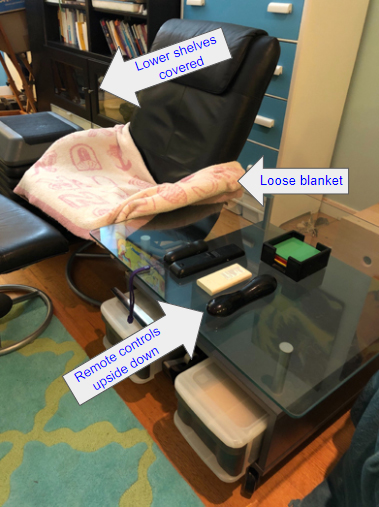 The Remote Control
The Remote Control
Scientific fact: The buttons on a remote control are absolutely irresistible chew-targets for rabbits. I suppose they have the consistency of a ripe piece of fruit, which would explain the first bite — but can they possibly taste good? Maybe the additional bites just feel good on the ol’ bunny overbite. Suffice it to say, entire remote controls have been devastated in one go and had to be replaced. The fix is easy: always leave your remote controls face down. That’s all it takes. Side note: more than once we have come home to find the television blaring. Somebody must have been cruising on the coffee table and stepped on the face-down remote just right!
Upholstered Furniture
For many years, I happened to have rabbits who were not interested in jumping up or chewing on furniture; so my upholstery was fine. Then one day, Sammy got up on the couch and immediately put a hole in a pillow, From then on, he was the Terror of The Sofa. (Sammy was actually a Terror of Many Things – see photo collage below)
You may never face this issue. I know plenty of people who have rabbits that hop up on their furniture but don’t try to destroy it. What to do if you are not so lucky?
One thing I have done that seems pretty effective is to lay some loose blankets over the furniture. This works well for our leather recliners. Bunny may get up there and dig/chew on the blanket, but it’s not as satisfying if the blanket doesn’t have much resistance to his tugging and tearing. My rabbits have pretty much lost interest in the chairs since I added the blankets. I would love to know if anyone else has tried a different strategy for upholstered furniture chewing that was effective.
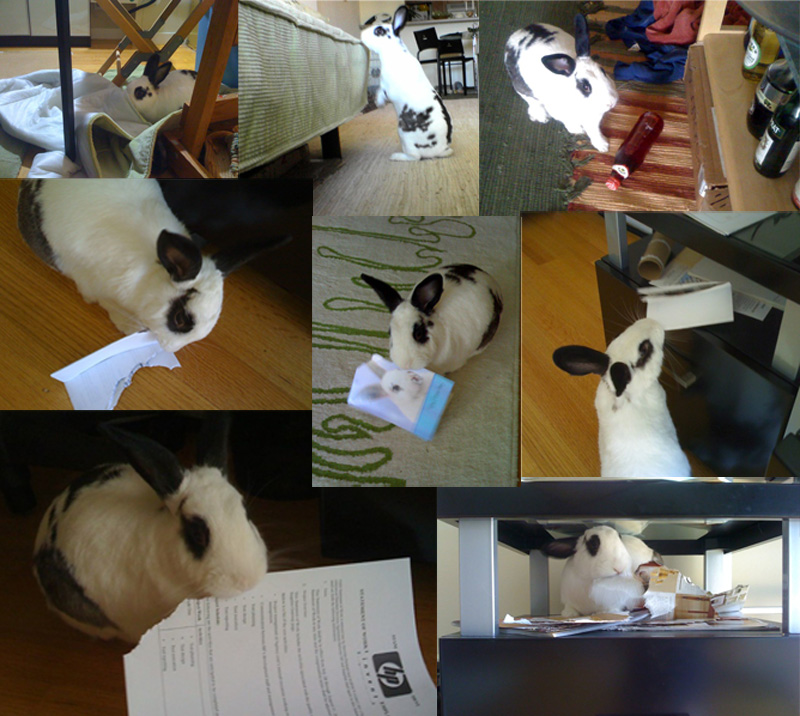
Carpet/Rugs
Not every rabbit will chew on floor coverings. But let’s face it: what could be more natural to a rabbit than to reach down to the ground and pull on something that is sticking up? So, a lot of them do.
My sister owns “investment quality” Persian rugs made of silk that look beautiful on her floor. No floor in any home of mine will ever experience such luxury.
Do I feel regret? On the contrary, I have found this liberating. When I buy a rug, it’s the cheapest one I can find that matches the decor. Once installed, it belongs to the rabbits. My sister gets the pleasure of seeing elegant home furnishings and can reach down and stroke the refined texture of her silk rugs. My luxury is petting the beautiful, silky soft creature sitting beside me on a cheap one.
I have learned to look for rugs that have a very short, tight weave. Anything that is shaggy or sticks up is begging to be tugged on! The harder it is to get a tooth-hold, the longer the rug will last.
For those who have carpet or rugs that they are extremely fond of, my recommendation is to cover them with cheap rugs and/or move them to a non-rabbit area. But here again, I’m interested in hearing if anyone else has found a better way to rabbit-proof floor coverings.
Anything that You Would Feel Shattered If It Got Chewed
Keep it out of reach!
Observe and Adapt
it’s important to keep an eye on what your bun does, and check the things that you have rabbit-proofed now and then to see if they have been or could be tampered with. This is especially important when a bunner first gets access to a new area, or when something novel is introduced at her level. But it really is an ongoing process. I just spent 10 minutes today underneath my work-from-home desk re-securing a bundle of cords that had started to hang a little low. Not sure if it was low enough to be chewed, but I don’t want to take any chances.
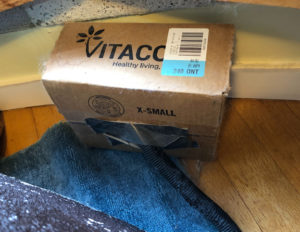
Lastly, always remember that cardboard boxes are your friends! if you need to create a barrier, baffle or distraction, grab one of those and a sharp knife – with care and adult supervision – and get creative. Chances are you can rig up something that will keep bunny at bay.
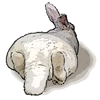
The Fluffy Tail of This Blog Post
Rabbit proofing may take some time and thought, but there are just a few basic safeguards to put in place. Once you have done your initial setup, maintaining it is pretty easy. Rabbit proofing will pay off tremendously in allowing you and your bunny to cohabit a space peacefully and safely. The joy of seeing your free-roaming whisker-nose sharing your home is its biggest reward!
In my next blog post, I’ll talk about the other half of rabbit management — the enrichment part.